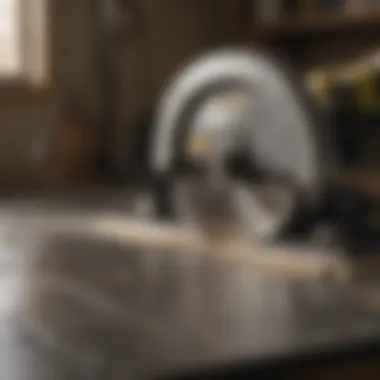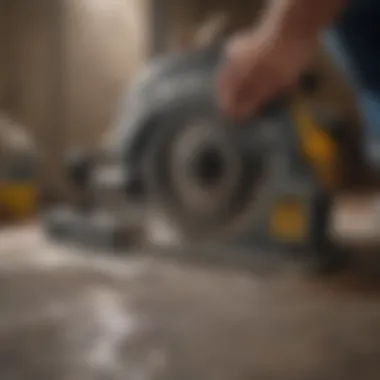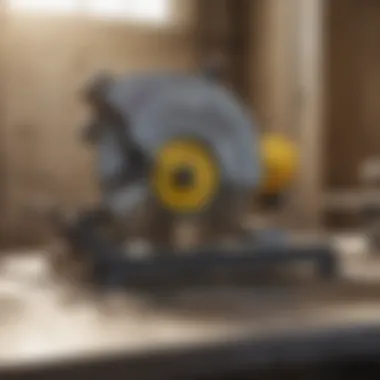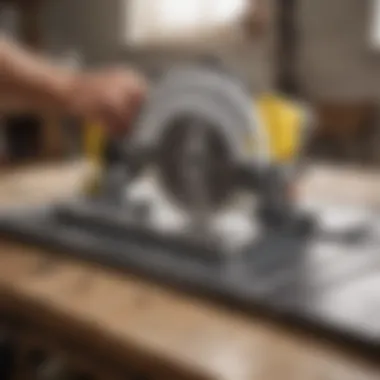Unveiling the Mastery of the Ryobi Ceramic Tile Wet Saw: An In-Depth Guide


Rock and Fossil Identification
As we delve into the world of rock and fossil identification, it becomes imperative to understand the diverse types of rocks and fossils that enthusiasts may encounter. From igneous, sedimentary, to metamorphic rocks, each boasts distinct characteristics waiting to be discovered. Fossils, on the other hand, offer windows to the past, showcasing ancient life forms preserved in geological records. When embarking on the journey of identification, keen observation becomes key, as subtle details such as color, texture, and structure unveil the secrets of these geological treasures. Additionally, having the right tools for identification, such as magnifying glasses, chisels, and field guides, equips collectors with the ability to discern finer nuances with precision and expertise.
Collecting Tips and Techniques
Unraveling the best practices for collecting rocks and fossils elevates the collecting experience from mere hobby to a systematic pursuit of knowledge. From scouring prime collecting sites rich in geological diversity to safely extracting specimens without compromising their integrity, collectors navigate a landscape rich in history and mystery. Embracing techniques that minimize environmental impact and adhere to ethical standards ensures the preservation of these geological wonders for future generations to appreciate. Whether it's delicately chiseling a trilobite from its rocky cradle or carefully excavating a mineral specimen, every step taken in the collection process contributes to the preservation and dissemination of invaluable geological heritage.
Preservation and Display
Transitioning from the thrill of discovery to the art of preservation, collectors immerse themselves in techniques aimed at conserving rocks and fossils for posterity. Exploring methods for maintaining the integrity of specimens through proper storage practices mitigates the risk of degradation and ensures longevity. Moreover, embracing creative display ideas breathes life into collections, transforming them into captivating exhibits that narrate the geological story of our planet. By amalgamating preservation techniques with innovative display strategies, collectors not only safeguard the authenticity of their finds but also share the wonders of the Earth with a broader audience.
Geological Insights
Unlocking the geological insights embedded within rocks and fossils unveils a tapestry of geological formations and processes that have shaped our planet over millennia. Delving into the historical significance of rocks and fossils sheds light on their roles as indicators of Earth’s past environments and inhabitants. Furthermore, exploring notable discoveries in the field offers a glimpse into groundbreaking revelations that have revolutionized our understanding of geology and paleontology. From ancient sedimentary layers revealing clues about past climates to fossils capturing evolution in action, each discovery presents a puzzle piece in the grand mosaic of Earth’s history waiting to be unraveled by discerning minds.
Introduction to the Ryobi Ceramic Tile Wet Saw
In this article, we embark on a comprehensive exploration of the Ryobi Ceramic Tile Wet Saw, a tool that stands out for its precision and efficiency in cutting and shaping ceramic tiles. The introduction sets the stage for a detailed journey into the various aspects of this wet saw, shedding light on its purpose, features, and why it has become a go-to choice for both novices and professionals in the tiling industry.
Understanding the Purpose of a Ceramic Tile Wet Saw


The significance of a ceramic tile wet saw lies in its ability to execute clean and accurate cuts on ceramic tiles, making it a fundamental tool for tile installation projects. Unlike other cutting tools, such as snap cutters or manual tile cutters, a wet saw uses water to cool the blade, reducing friction and preventing damage to the tile surface. This results in smooth, precise cuts that are imperative for achieving seamless tile installations. By understanding the purpose of a ceramic tile wet saw, users can grasp its unique role in enhancing the precision and quality of tile work.
Overview of Ryobi as a Brand
Delving into the brand landscape of Ryobi unveils a legacy of innovation and reliability in the realm of power tools. With a commitment to delivering high-performance tools at accessible prices, Ryobi has established itself as a reputable name among DIY enthusiasts and professionals alike. The brand's dedication to quality, durability, and user-friendly designs sets it apart in the market, garnering trust and loyalty from a diverse user base. A glimpse into Ryobi's brand ethos provides valuable insights into the craftsmanship and credibility embodied by the Ryobi Ceramic Tile Wet Saw.
Why Choose the Ryobi Ceramic Tile Wet Saw
When it comes to selecting a ceramic tile wet saw, several compelling reasons point to the Ryobi as a top choice. One of the primary attractions lies in Ryobi's reputation for producing reliable and high-performance tools that cater to the needs of both amateur and seasoned craftsmen. Additionally, the Ryobi Ceramic Tile Wet Saw boasts features such as a precise cutting capacity, efficient water cooling system, and user-friendly operation, making it a versatile and practical tool for various tiling projects. Choosing the Ryobi can bring a blend of efficiency, accuracy, and ease of use to the tile cutting process, enhancing overall productivity and craftsmanship.
Key Features of the Ryobi Ceramic Tile Wet Saw
In the realm of ceramic tile cutting tools, understanding the key features of the Ryobi Ceramic Tile Wet Saw is paramount. This section delves into the intricacies that define this tool, shedding light on its functionality and benefits for users at various skill levels. From its blade type and size to its water system and cutting accuracy, each element plays a crucial role in ensuring a smooth and precise cutting experience.
Blade Type and Size
The blade type and size of the Ryobi Ceramic Tile Wet Saw are pivotal factors that significantly impact the cutting performance and versatility of the tool. Equipped with a high-quality diamond blade, this saw ensures efficient cutting of ceramic tiles with precision. The size of the blade is carefully chosen to balance between cutting capacity and accuracy, allowing users to tackle a variety of tile sizes and shapes with ease. The choice of blade type influences the smoothness and cleanliness of the cuts, making it an essential consideration for achieving professional results in tile cutting projects.
Water System and Cooling Mechanism
Another standout feature of the Ryobi Ceramic Tile Wet Saw is its advanced water system and cooling mechanism. The inclusion of a water reservoir and pump mechanism ensures continuous water flow over the blade during operation, effectively reducing friction and heat buildup. This not only prolongs the lifespan of the blade but also enhances cutting efficiency by maintaining a cooler temperature throughout the cutting process. The cooling mechanism contributes to cleaner cuts and minimizes the risk of tile breakage, making it a crucial component for achieving precise and professional results.


Cutting Capacity and Accuracy
The cutting capacity and accuracy of the Ryobi Ceramic Tile Wet Saw are engineered to meet the demands of both DIY enthusiasts and professional tile installers. With a generous cutting capacity and adjustable cutting depth, this tool offers versatility in handling tiles of various thicknesses. Additionally, the saw's precise cutting guides and adjustable angles ensure accurate cuts, allowing users to create intricate patterns and designs with ease. Whether cutting straight lines or complex shapes, the Ryobi wet saw delivers reliable performance and unmatched accuracy, making it a must-have tool for any tile cutting project.
Operating the Ryobi Ceramic Tile Wet Saw
In the extensive realm of ceramic tile cutting, understanding how to operate the Ryobi Ceramic Tile Wet Saw is quintessential for achieving impeccable results. This section plays a pivotal role in our overarching goal of delving into the nuances of this power tool. Operating the Ryobi Ceramic Tile Wet Saw effectively requires a deep dive into its setup, maintenance, and safety considerations to ensure a seamless cutting experience.
Setting Up the Saw for Use
Before embarking on any cutting endeavors, setting up the Ryobi Ceramic Tile Wet Saw correctly is imperative. The initial steps involve assembling the components, attaching the water system for cooling, and adjusting the cutting parameters according to the tile thickness. Proper alignment of the blade and setting the cutting depth are crucial for precise cuts. Ensuring that the saw is placed on a stable surface and the workspace is well-ventilated adds to the operational efficiency.
Basic Cutting Techniques
Mastering the basic cutting techniques with the Ryobi Ceramic Tile Wet Saw sets the foundation for intricate tile designs. Understanding the fundamental principles of making straight cuts, diagonal cuts, and notches will elevate the quality of your work. Proper positioning of the tile, steady hand movements, and controlled feed rate are key elements in achieving clean and accurate cuts. Moreover, familiarizing yourself with adjusting the saw's settings for different tile densities enhances versatility in your cutting approach.
Advanced Tips for Precision Cuts
For those seeking perfection in their tile cutting endeavors, incorporating advanced tips for precision cuts elevates the outcome to a professional level. Techniques such as miter cuts, bevel cuts, and intricate patterns require a combination of skill and technique. Utilizing auxiliary tools like angle guides and cutting aids can facilitate intricate designs with utmost accuracy. The significance of blade maintenance, regular calibration, and continuous practice cannot be overstated when striving for precision in your ceramic tile projects.
Maintenance and Care for Your Ryobi Ceramic Tile Wet Saw


Maintenance and care are essential components of maximizing the longevity and performance of your Ryobi Ceramic Tile Wet Saw. As a pivotal section in this comprehensive guide, understanding the importance of properly maintaining and caring for your equipment is crucial. By incorporating routine maintenance practices, you not only ensure the efficiency of your saw but also guarantee the quality of your ceramic tile cuts.
Cleaning and Lubrication
Cleaning and lubricating your Ryobi Ceramic Tile Wet Saw is imperative for its smooth operation and durability. Regularly removing debris, dirt, and residue build-up from the blade, water reservoir, and other components not only enhances precision cutting but also prevents damage. Utilizing a mild cleaning solution and a soft brush to gently cleanse the saw after each use is highly recommended. Additionally, lubricating moving parts with the appropriate lubricant ensures seamless functionality and reduces wear and tear on essential components.
Blade Replacement and Alignment
Proper blade maintenance is paramount to the performance of your Ryobi Ceramic Tile Wet Saw. Over time, blades become dull, affecting the accuracy and quality of cuts. Regularly inspecting the blade for signs of wear and tear and replacing it when necessary is essential. Correct blade alignment is also crucial for precise cutting. Ensuring the blade is properly aligned prevents jagged cuts and potential safety hazards. Following manufacturer guidelines for blade replacement and alignment guarantees optimal saw performance.
Storage Recommendations
Efficient storage of your Ryobi Ceramic Tile Wet Saw is key to safeguarding its longevity. Storing the saw in a clean, dry environment away from moisture and extreme temperatures prevents rust and damage to sensitive components. Covering the saw when not in use shields it from dust and debris accumulation. Properly securing the power cord and any accessories reduces the risk of damage during storage. Adhering to proper storage practices prolongs the life of your saw and maintains its operational excellence.
Safety Guidelines When Using the Ryobi Ceramic Tile Wet Saw
When delving into the realm of ceramic tile cutting, safety should be paramount. The Ryobi Ceramic Tile Wet Saw, with its precise capabilities, requires adherence to specific safety guidelines to ensure a secure working environment and optimal results. Understanding and implementing safety measures not only safeguard the user but also contribute to the longevity of the tool. By following these guidelines diligently, users can elevate their experience with the Ryobi Ceramic Tile Wet Saw.
Personal Protective Equipment (PPE)
Utilizing appropriate Personal Protective Equipment (PPE) is non-negotiable when operating the Ryobi Ceramic Tile Wet Saw. PPE includes but is not limited to safety goggles to shield the eyes from debris, a dust mask for respiratory protection, gloves to safeguard the hands, and ear protection due to the saw's operational noise. Wearing suitable PPE not only reduces the risk of injuries but also enhances operator comfort and efficiency, ensuring a smooth cutting process without compromising safety.
Precautionary Measures
Precautionary measures play a crucial role in mitigating potential hazards when using the Ryobi Ceramic Tile Wet Saw. Before commencing any cutting task, it is essential to inspect the saw for any damage or abnormalities that may impede its function. Additionally, securing the workpiece firmly and setting the blade depth correctly minimizes the risk of kickbacks and ensures smooth cutting operations. Taking time to assess the workspace for any obstructions or potential safety hazards is essential for accident prevention and overall operational safety.
Emergency Protocol
Even with meticulous preparation and adherence to safety measures, unforeseen circumstances can arise. Establishing an emergency protocol is indispensable to handle unexpected incidents efficiently. In the event of a malfunction or injury, it is crucial to have a clear plan in place. This includes knowing the location of emergency stops on the saw, maintaining first aid kits nearby, and having emergency contact information readily accessible. Being proactive in establishing an emergency response protocol can mitigate risks and ensure a swift and effective response to any unforeseen situations.







